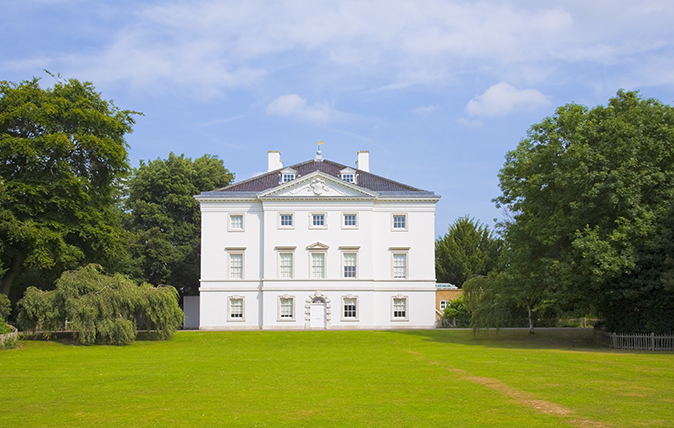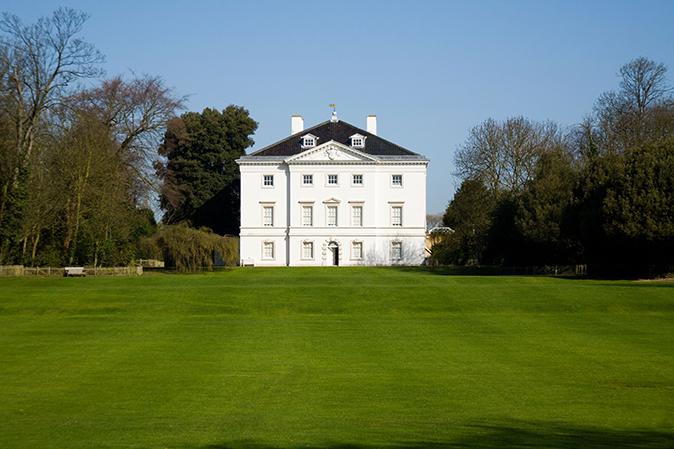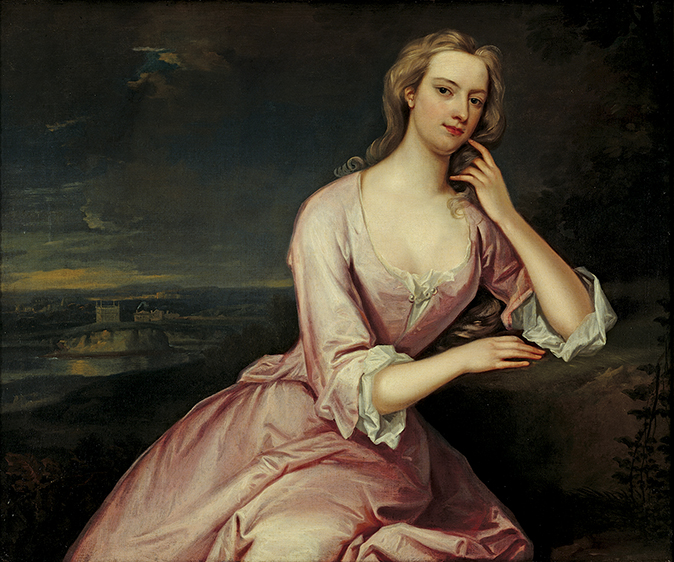Marble Hill, Richmond-upon-Thames: Restored to good nature
A restoration project that aims to revive the landscape garden setting of an outstanding 18th-century villa throws new light on the gardening interests of Alexander Pope and the attractive personality of its patroness, as Tim Richardson discovers.


Marble Hill has been hiding in plain sight for some time. Built by one of the most remarkable women of the 18th century with the assistance of local notables including Alexander Pope (in his guise as a garden designer), the estate became a public park in 1902. Subsequently, its definition as a house and ‘pocket landscape garden’ of singular character has become blurred over decades of service as a local amenity. By the late 20th century, Marble Hill was widely thought of as a public park that happened to have an early-Georgian house at its centre.
This is now set to change by means of a £6 million restoration plan (including £4 million from the Heritage Lottery Fund) to be implemented by English Heritage (EH). The most important historical aspect of the plan is the rationalisation and replanting of the wooded areas of the estate, which have become overgrown and lack variety in tree and shrub content.
However, plans have not run as smoothly as the restoration team would have wished. John Watkins, EH’s head of gardens, and his colleagues must tread a delicate path as they seek to secure planning permission from the local authority (Richmond-upon-Thames) to facilitate both the restoration work and the creation of a new, enlarged cafe behind the stable block.

They also need to satisfy a vocal sector of local public opinion that is sceptical about increased visitor numbers, woodland-management proposals (including tree-felling), the size of the cafe and potential restrictions on dogs. There are even suggestions being made online that there was never a designed landscape at all at Marble Hill and that what is being proposed is fantasy – although the historical record tells a different story.

The creator of Marble Hill was Henrietta Howard, later Countess of Suffolk, who escaped an abusive marriage to become Lady of the Bedchamber to Princess Caroline in 1714 and then mistress to Prince George (later George II) from about 1718 until 1732. The semi-official role of mistress was established, it seems, with the co-operation of Princess Caroline herself, who was close friends with Mrs Howard and knew she would not attempt to undermine her at Court or otherwise behave unpredictably.
Mrs Howard’s intelligence combined with her good nature were widely attested to, with even Lord Hervey – who could be scathing – stating: ‘Good sense, good breeding, and good nature were qualities which even her enemies could not deny her… She was civil to everybody, friendly to many, and unjust to none.’

In 1723, the Prince made Mrs Howard a startlingly generous gift of £11,500 (in stock) with which to build a new house and lay out a Thamesside garden, thus allowing her to gain independence from her husband. Marble Hill emerged as a suitable residence for a lone woman of connoisseurship and conducive to Mrs Howard’s roster of guests, which comprised ladies of the Court, helpless suitors (notably Lord Peterborough, who also tried to help with the garden’s design) and freeloading poets, including Pope, John Gay and Jonathan Swift.
Exquisite houses, the beauty of Nature, and how to get the most from your life, straight to your inbox.
The compact, wing-less Palladian villa of 1724–29 was designed by Henry Herbert, later 9th Earl of Pembroke, with his usual collaborator, Roger Morris. Neo-Palladianism as a style – in fact, at least as much a revival of the work of Inigo Jones as that of the eponymous 16th-century architect Andrea Palladio – was by now well established as the architectural brand of the Hanoverian succession. The delicacy and simplicity of Marble Hill, however, especially when compared with some of the vast houses then being designed for Whig grandees by Colen Campbell, was in line with Prince George’s own taste for a simpler, ostensibly more refined Palladianism to set his circle apart from his father’s Court, from which he had been banished.

The garden, with a smooth oval lawn flanked by wooded areas with decorative glades and a series of stepped terraces down to the river, was to be a refined pendant to the house.
It has long been suspected that Pope had a hand in the design of the garden – Swift described him as ‘the contriver of the gardens’ in his 1727 poem about Marble Hill – and new archival work appears to confirm it. A near neighbour, Pope was devoted to Mrs Howard (as, it seems, were most men of her acquaintance) and it is likely she visited him at his garden at Twickenham as it was taking shape in the early 1720s.
In a letter to Martha ‘Patty’ Blount in 1724, Pope begged her: ‘Don’t let any lady from hence imagine that my head is so full of any Gardens as to forget hers. The greatest proof I could give her to the contrary is, that I have spent many hours here in studying for hers, & in drawing new plans for her.’

What plans were these? Sketches by Pope on the back of some sheets of his Odyssey translation may have been of Marble Hill and a much more detailed but undated and unsigned plan in the Norfolk Record Office bears a strong similarity to it, with detail of serpentine paths, a labyrinth and woodland diversions. Emily Parker, landscape adviser at EH, has reinforced the attribution of the Odyssey sketches both to Pope and to Marble Hill by noticing that it contains a reference to ‘Plumbush’, the name of one of the Marble Hill fields acquired by Mrs Howard.

The estate boundaries shown in the Norfolk plan would date it precisely to 1724. The gardened area at Marble Hill was, indeed, relatively small and the meadows north of the house were used for grazing sheep. Pope’s and Mrs Howard’s friend Lord Bathurst sent over lambs to start a flock, along with a consignment of lime trees. Within a few years, visitors were commenting enthusiastically on the pleasant woodland walks filled with flowers. This bucolic atmosphere was what came to define Marble Hill and was celebrated in poems by Swift and Gay, who had a running joke with their hostess that she was a ‘shepherdess’ and they her unruly swains.

Gay was close to Mrs Howard and Swift briefly became a good friend in 1726–27, styling himself her butler and predicting the end of the idyll in verse by speaking in the ‘voice’ of the estate:
No more the Dean, that grave Divine, Shall keep the Key of my (no) wine; My Ice-house rob as heretofore, And steal my Artichokes no more; Poor Patty Blount no more be seen Bedgraggled in my Walks so green: Plump Johnny Gay will now elope; And here no more will dangle Pope.
The restoration plan for the garden at Marble Hill is largely based on a detailed survey dated to 1752. There are no plans at this time to re-create the buildings; the emphasis is on enhancing the overall atmosphere of the estate by means of increased diversity in tree and shrub plantings. The species proposed are far from exotic – they include limes, birches, hornbeams, oaks and beech – but will add much greater variety and interest, as, at present, the dense woodland of the glades comprises mainly self-seeded sycamore, yew and holly and areas nearer the river are more open than they ought to be.

The original avenues of horse chestnuts leading south towards the river, flanking the terraces, are to be rejuvenated and redefined and the terraces are to be ‘sharpened’ so their edges are clear. A palisade or arcade of clipped trees in four separate sections is to be reinstated around the perimeter of the oval lawn and the sward will be improved, along with drainage at the site, which is on a flood plain. Double lime avenues are to be replanted at the eastern and western edges of the estate, leading down to the Thames, to reassert the boundaries.

Each of the four glade areas was possessed of a distinct character and an effort is being made to reinstate something of this. On the eastern side, a flower garden (mentioned in several contemporary texts) is to be introduced and the area around the existing grotto is to be planted with trees so that the feature is discovered among them, as opposed to simply erupting from the lawn.
It is perhaps regrettable that there are no plans to restore the underground grotto (originally covered with corals and minerals, just as Pope’s grotto was in its first incarnation) or indeed the associated ground-level rustic grot, but this would be an expensive and ambitious addition at this stage.
On the western side, the ‘thicket’ around the Ice House is to be replanted as a fragrant shrubbery with winding sandy walks and there are hopes that the modest Ice House Seat, facing south, might be reinstated. The nine-pin alley in the south-west glade area is also to be restored, creating an open area in which this form of skittles can be played. Coppicing of the yews and hollies here will encourage new growth and help open up these areas to sunlight so that bulbs and other woodland plants can thrive again. Ugly municipal-style railings and redundant buildings such as an old toilet block will be removed.

Given the current controversy over the plans, one hopes that Mrs Howard may yet cast her benign and sociable spell over Marble Hill for, as Pope reported: ‘She has as much Good nature, as if she had never seen any ill nature, and had been bred among Lambs and Turtle-doves, instead of Princes and Court-Ladies.’

Country Life Top 10: Fireplaces – The best hearths and chimneypieces you can buy
Giles Kime casts his eye over the finest fireplaces in the land.

The right royal reason that this broken wine glass sold for £25,000 at auction
Huon Mallalieu takes a look at two magnificent objects which sold at auction this summer, including a wine glass used

Virginia Woolf's exquisite Richmond townhouse comes up for sale
Virginia Woolf’s former home and birthplace of the Hogarth Press has been converted into two exquisite townhouses in the centre
Country Life is unlike any other magazine: the only glossy weekly on the newsstand and the only magazine that has been guest-edited by His Majesty The King not once, but twice. It is a celebration of modern rural life and all its diverse joys and pleasures — that was first published in Queen Victoria's Diamond Jubilee year. Our eclectic mixture of witty and informative content — from the most up-to-date property news and commentary and a coveted glimpse inside some of the UK's best houses and gardens, to gardening, the arts and interior design, written by experts in their field — still cannot be found in print or online, anywhere else.
